 The Phase Change Matters e-mail newsletter is a weekly summary of the latest news and research on phase change materials and thermal energy storage. To subscribe, visit www.puretemp.com/subscribe. For more frequent updates, follow @puretemp on Twitter or visit the Phase Change Matters blog, www.puretemp.com/pcmatters.
The Phase Change Matters e-mail newsletter is a weekly summary of the latest news and research on phase change materials and thermal energy storage. To subscribe, visit www.puretemp.com/subscribe. For more frequent updates, follow @puretemp on Twitter or visit the Phase Change Matters blog, www.puretemp.com/pcmatters.
ARCHITECTURE
10-star energy home features 600 kg of biobased PCM
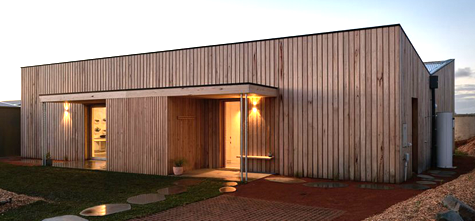
All new homes in Australia must meet energy efficiency standards set in the National Construction Code, which includes the option of complying with the 6 Star Standard. Stars are calculated using computer simulation at the design stage to assess thermal performance based on elements such as orientation, layout, materials, insulation and glazing. The more stars, the better the thermal performance.
Victoria’s first 10-star energy home, completed in 2017, is estimated to cost only $3 a year to heat, cool and light. The two-bedroom, two-bathroom home features a 5kW photovoltaic solar roof, highly efficient LED lighting, cross-flow ventilation, industrial concrete floors, under-slab insulation, double-glazed windows and biobased phase change material in the walls and ceilings.
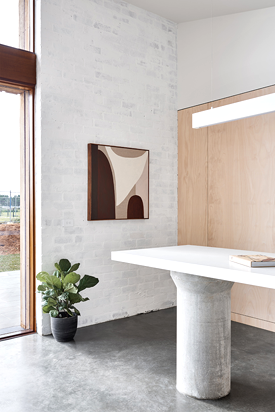 The 160-square-meter home was built by The Sociable Weaver of Melbourne in collaboration with Clare Cousins Architects. Natalie Woods, marketing manager at Sociable Weaver, answered questions about the project.
The 160-square-meter home was built by The Sociable Weaver of Melbourne in collaboration with Clare Cousins Architects. Natalie Woods, marketing manager at Sociable Weaver, answered questions about the project.
Q: The 10 Star Home has been described as “Australia’s first 10 star rated, carbon positive and zero waste home.” Is that accurate?
A: “The 10 Star Home is Victoria’s first home to have a 10 star energy rating. We believe it to also be the first home in Australia to be carbon positive, 10 star rated, and built to zero waste and building biology principles.”
Q: What is the home’s status?
A: “The 10 Star Home is a permanent display home – this is so it can serve as an education resource to the public and to our industry peers. We also run our coastal office from the home, which means we can monitor the home’s performance across all four seasons.”
Q: Has your company worked with PCM before? How did you hear about it?
A: “This is the first time we’ve used BioPCM in a build. It was recommended by our consultant Tim Adams at F2 Design.”
Q. Who supplied the PCM?
A: “The BioPCM was supplied by Phase Change Energy Solutions of Mitcham, Victoria. The melt temperature range is 20-24C. It is contained in mats made of food-grade plastic.”
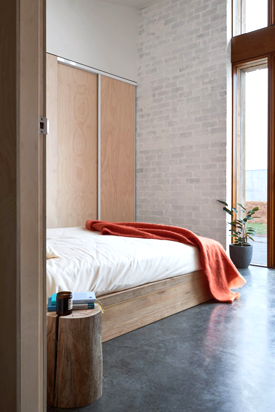 Q: How much PCM is used in the home?
Q: How much PCM is used in the home?
A: “The ceiling is 162sqm at 2.7kg/sqm = 437kg and the walls 61sqm = 165kg.”
Q: Is PCM used in a mostly passive manner, assisted by natural ventilation with occasional help from ceiling fans?
A: “The 10 Star Home has been designed to maximum passive solar heating and natural cooling – this includes maximizing northerly sun through large north-facing double-glazed windows, thermal mass in concrete slab flooring and BioPCM insulation in the walls and ceiling.”
Q: What kind of feedback are you getting from people who tour the house, and those who work in the office there?
A: “When people walk into the 10 Star Home, often from the cold windy Victorian weather outside, they always remark how warm it is inside the home. The team who work in the home find the space is always a beautifully comfortable temperature inside, no matter what the weather is outside. We can’t wait to use this innovative product in a client’s home and see how it can benefit a family day-to-day.”
Q: What lessons have you learned that will help you improve your next 10-star home – and where will it be built?
A: “It took a long time to get the design of the home perfect to ensure the carbon positive and 10 Star energy rating, so this was definitely a lesson in patience for everyone involved – but it was well worth it! We’re still using the current 10 Star Home as a showcase to industry and clients so don’t have plans to build another one just yet, however it would be great to build one in another location in Australia to showcase how the 10 star energy rating can be achieved in different climates.”
Q: Have you since used PCM products in any other projects?
A: “We haven’t used Bio-PCM in any of our latest projects but are hoping to use it again soon as we’ve found it to be so effective in the 10 Star Home.”
PATENTS
Moisture wicking and cooling capsules with a siloxane outer shell
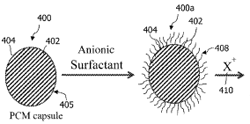 U.S. patent application 20180242665 (applicant Microtek Laboratories Inc., Dayton, Ohio):
U.S. patent application 20180242665 (applicant Microtek Laboratories Inc., Dayton, Ohio):
“Microcapsules or macrocapsules have a core composition that includes a phase changing material (PCM) encapsulated within a polymer wall with an outer shell having a siloxane tethered to an exterior surface of the polymer wall by a surfactant. The siloxane may form a crystalline or a sol-gel outer shell. Methods of making such capsules and textile fabrics and clothing incorporating such capsules include treating pre-formed capsules with a surfactant solution followed by treating with a compound containing a siloxane functional group. The surfactant connects or tethers the siloxane to the exterior surface of the polymer wall and the siloxane forms an outer shell of the capsules.”
Phase change materials and methods of regulating temperature
U.S. patent application 20180244971 (applicant Croda International PLC, Yorkshire, Great Britain):
“The present invention provides a phase change material composition comprising an ester of a linear alcohol which has at least 4 carbon atoms and a linear carboxylic acid which has at least 4 carbon atoms, wherein the total number of carbon atoms in the ester is in the range from 13 to 31. The invention also provides products including the phase change material composition and methods of regulating temperature.”
IN BRIEF
• In an interview with Energy Storage Report, CEO Mike Hopkins discussed Ice Energy’s plans to distribute its ice-based thermal energy storage technology in Australia, Mexico and Saudi Arabia. In June, the California company announced a $40 million cash infusion from Argo Infrastructure Partners to finance the delivery of Ice Energy’s residential and commercial thermal storage contracts.
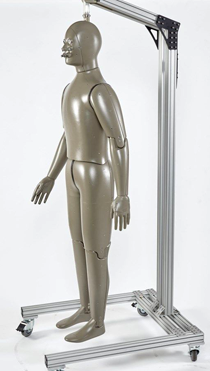 • Thermetrics says its new ANDI sweating thermal manikin has the “unrivaled ability” to measure both positive and negative heat flux and to respond to changing environmental conditions with “unprecedented” speed and accuracy. The new manikin was unveiled this week at the 12th International Meeting of Manikins and Modeling, hosted by the Swiss research institute Empa, in St. Gallen, Switzerland. The manikin can be used to evaluate the thermal performance of apparel, blankets and seats, as well as quantify the cool-to-touch or warm-to-touch temperature-buffering effect in fabrics containing phase change materials.
• Thermetrics says its new ANDI sweating thermal manikin has the “unrivaled ability” to measure both positive and negative heat flux and to respond to changing environmental conditions with “unprecedented” speed and accuracy. The new manikin was unveiled this week at the 12th International Meeting of Manikins and Modeling, hosted by the Swiss research institute Empa, in St. Gallen, Switzerland. The manikin can be used to evaluate the thermal performance of apparel, blankets and seats, as well as quantify the cool-to-touch or warm-to-touch temperature-buffering effect in fabrics containing phase change materials.
• New from LP Information: “2018-2023 Global Eutectic Phase Change Material Consumption Market Report“
• New from Research and Markets: “Phase Change Materials (PCMs) – A Global Market Overview“
• The journal Nature reports that India is cracking down on predatory journals, publications that “actively solicit manuscripts and charge authors hefty fees without providing the services they advertise, such as editing and peer review.”
• Life science laboratories are finding creative ways to reduce the amount of plastic they throw away, The Scientist reports.
• Sonoco ThermoSafe will hold its next Leading Minds Seminar Nov. 6-7 at the Sheraton Skyline Hotel Heathrow, London, England. Co-hosted by ELPRO, the seminar is a chance for pharmaceutical manufacturers, supply chain partners and government representatives to discuss temperature-assurance packaging and data monitoring in a collaborative environment.
• Viking Cold Solutions says the PCM-based thermal energy storage system the company installed at a 93,000-square-foot frozen food distribution center in Richmond, Calif., has reduced peak period energy consumption by up to 43 percent and reduced overall freezer energy consumption by 35 percent. The Houston company installed the system at the Dreisbach Enterprises warehouse earlier this year.
RESEARCH ROUNDUP
For our full list of recent academic research, see puretemp.com/academic. Here are highlights from the past week:
From Sustainable Cities and Society:• A review on applications of shape-stabilized phase change materials embedded in building enclosure in recent ten years
From Solar Energy Materials and Solar Cells:
• Microencapsulation of eutectic and hyper-eutectic Al-Si alloy as phase change materials for high-temperature thermal energy storage
From Journal of Chemical Thermodynamics:
• Thermal analysis and heat capacity study of polyethylene glycol (PEG) phase change materials for thermal energy storage applications
From Exergy for A Better Environment and Improved Sustainability:
• Investigation of Thermal Characteristic of Eutectic Fatty Acid/Damar Gum as a Composite Phase Change Material (CPCM)
From Composites Part B: Engineering:
• Fabrication, morphology and thermal properties of octadecylamine-grafted graphene oxide-modified phase-change microcapsules for thermal energy storage
From Chemical Engineering Transactions:
From International Journal of Low-Carbon Technologies:
• Free cooling using phase change material for buildings in hot-arid climate
From International Journal of Energy Research:
• Experimental study on cold storage box with nanocomposite phase change material and vacuum insulation panel
NETWORKING
Connect with PCM experts and industry leaders on LinkedIn
 More than 1,300 people have joined a LinkedIn group devoted to the discussion of phase change material and thermal energy storage. The Phase Change Matters group is an interactive complement to the award-winning blog and newsletter of the same name.
More than 1,300 people have joined a LinkedIn group devoted to the discussion of phase change material and thermal energy storage. The Phase Change Matters group is an interactive complement to the award-winning blog and newsletter of the same name.
You are invited to join the group and connect with PCM and TES experts from around the world. This week we welcome Rusty Pittman, vice president of marketing and business development at Elevance Renewable Sciences Inc., Woodridge, Ill.; Liam Holmes, engineering team lead for Europe and Asia at Sonoco ThermoSafe, Mallow, Ireland; Joel Mathew, mechanical engineering graduate student at North Carolina State University; and Sujal Bhavsar, project associate at the Indian Institute of Technology Kanpur. Sujal writes:
“I graduated with BE in Mechanical Engineering in April 2018. I did a project on PCM as my undergraduate thesis. The project was on PCM integrated window for temperature control in the building. You will find more information in my LinkedIn profile. The purpose of joining this group is to explore upon PCM application. And find the scope of doing innovative [work] on a market level.”